Rhodocollybia maculata (Alb. & Schwein.) Singer - Spotted Toughshank
Phylum: Basidiomycota - Class: Agaricomycetes - Order: Agaricales - Family: Marasmiaceae
Distribution - Taxonomic History - Etymology - Identification - Culinary Notes - Reference Sources
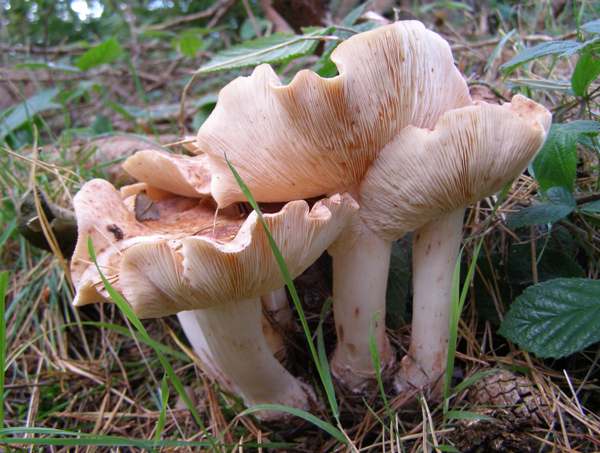
Fruiting most often in small groups or clusters, this very attractive litter-rotting fungus is not a fussy feeder: it occurs under conifers (particularly under pines) and much less often under deciduous hardwood trees. It is such a delight to come across a group in prime condition, particularly if you have opportunities to observe over several days the almost magical appearance of the reddish spots; they show up first on the cap surface and then later near the stem base before finally also erupting randomly from the gills.
Distribution
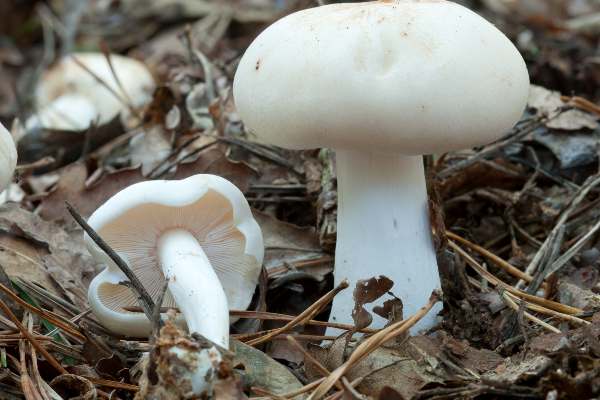
Common and widespread across Britain and Ireland and in mainly northern and central countries on mainland Europe, the Spotted Toughshank occurs also in parts of North America, including Canada.
Taxonomic history
The Spotted Toughshank was described scientifically in 1805 by German-American mycologists Johannes Baptista von Albertini (1769 - 1831) and Lewis David von Schweinitz (1780 - 1834), who gave it the binomial name Agaricus maculatus. (In the early days of fungal taxonomy most gilled mushrooms were placed in the genus Agaricus, which was later broken up into the many other genera that we use today.) The currently-accepted scientific name of the Spotted Toughshank was established in 1939, when German-born mycologist Rolf Singer transferred this species to the genus Rhodocollybia.
Synonyms of Rhodocollybia maculata include Agaricus maculatus Alb. & Schwein., Collybia maculata Alb. & Schwein.) P. Kumm., Collybia maculata var. maculata (Alb. & Schwein.) P. Kumm., Agaricus maculatus var. immaculatus Cooke, Collybia maculata var. immaculata (Cooke) Massee, and Rhodocollybia maculata var. maculata (Alb. & Schwein.) Singer.
The synonym Collybia maculata still appears in many modern field guides, but this fairly common woodland mushroom now seems to be comfortably settled in its new genus home Rhodocollybia, along with the Butter Cap and a few other former members of the former Collybia toughsank gang.
Etymology
The pinkish tinge to the gills provides a clue to the genus name Rhodocollybia, as the prefix Rhod- means pink (as in Rhododendron). The second part of the generic name -collybia is also Latin and means a small coin. The nickname Pink Penny comes to mind, therefore, although as I made it up it is perhaps now best forgotten.
As you might expect, the specific epithet maculata means spotted (just as immaculate means spotless).
Identification guide
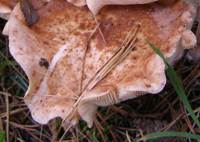 |
Cap5 to 12cm across; broadly convex, flattening with a wavy margin that often turns upwards to create an irregular saucer shape; creamy or pinkish white, developing tan spots or blotches. |
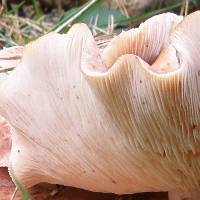 |
GillsAdnexed, adnate, emarginate or sometimes free of the stem; crowded; white, developing rust-like reddish-brown spots with age. |
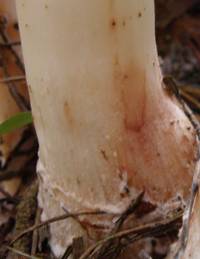 |
Stem5 to 10cm long and 0.8 to 1.2cm dia.; white, developing rust-like reddish-brown spots; no ring. |
SporesEllipsoidal to subspherical, smooth, 5.5-6.5 x 4.5-5.5µm. Spore printCream, often with a pinkish tinge. |
|
Odour/taste |
Odour not distinctive; taste bitter (and so unpleasant as to make them inedible). |
Habitat & Ecological role |
Saprobic, on needle litter, lignin-rich soil or well rotted buried wood, mainly under conifers but occasionally also in deciduous woodland. |
Season |
June to November in Britain and Ireland. |
Similar species |
Rhodocollybia distorta is a much less common species with a dry, red cap and a more swollen base below a twisted stem; its gills are not spotted. Rhodocollybia butyracea is usually darker and has a very greasy cap; its gills are not spotted. |
Culinary Notes
The Spotted Toughshank is tough and bitter tasting, and so although not known to be a seriously poisonous mushroom this species is generally considered inedible and of no culinary value.
Reference Sources
Fascinated by Fungi, 2nd Edition, Pat O'Reilly 2016, reprinted by Coch-y-bonddu Books in 2022.
Dictionary of the Fungi; Paul M. Kirk, Paul F. Cannon, David W. Minter and J. A. Stalpers; CABI, 2008
BMS List of English Names for Fungi
Taxonomic history and synonym information on these pages is drawn from many sources but in particular from the British Mycological Society's GB Checklist of Fungi.
Acknowledgements
This page includes pictures kindly contributed by David Kelly.
Fascinated by Fungi. Back by popular demand, Pat O'Reilly's best-selling 450-page hardback book is available now. The latest second edition was republished with a sparkling new cover design in September 2022 by Coch-y-Bonddu Books. Full details and copies are available from the publisher's online bookshop...

